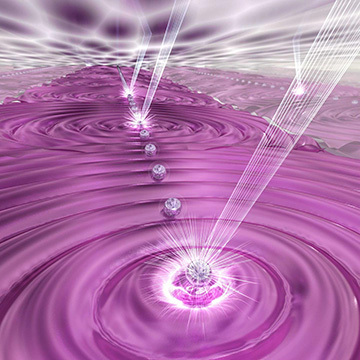
In the University of Maryland/Joint Quantum Institute work, lasers manipulated an array of more than 50 trapped ions to study the dynamics of quantum magnetism. [Image: E. Edwards/JQI]
In the daunting quest to build full-blown, universal quantum computers, capable of tackling problems beyond the reach of today’s classical machines, the creation of so-called quantum simulators has offered a tempting interim target. These simulators are designed not to be arbitrarily programmable, but instead to model specific quantum systems that conventional computing algorithms can’t easily replicate. A sufficiently large simulation would demonstrate quantum computing’s potential power—and, perhaps, offer a platform for moving toward general-purpose quantum machines.
At the end of November 2017, two U.S. research groups announced a big step forward in such quantum simulation. Leveraging different systems of trapped atoms or ions, the two groups were able to confine and manipulate more than 50 individual interacting quantum bits, or qubits, and to use them to simulate physics all but intractable with a classical computer (Nature, doi: 10.1038/nature24622, 10.1038/nature24654). A third research team based in the United States, Singapore and Greece performed a separate quantum simulation, using nine qubits, on a very different, superconducting-circuit platform involving a quantum chip from Google (Science, doi: 10.1126/science.aao1401).
None of the systems is a fully formed quantum computer—yet. But some of them could be configured to solve a specific class of difficult optimization problems that crop up in a variety of areas, as well as other problems in quantum physics. And, with additional engineering to scale up the number of qubits and the lasers, control systems and circuits that manage them, the simulators could evolve closer and closer to full-scale quantum computers.
“Magic number”
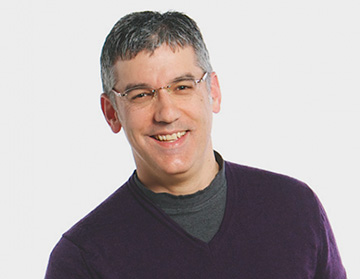
Christopher Monroe. [Image: University of Maryland]
Of the three studies, the two involving trapped atomic systems seem particularly significant, given the size of the state space—the number of qubits and, thus, possible configurations. “Fifty is sort of a magic number, because that’s the level where things become impossible to calculate” using classical algorithms, according to Christopher Monroe of the University of Maryland and the Joint Quantum Institute (JQI), the team leader on the trapped-ion study. “So everybody’s sort of aiming for that number now.”
Monroe’s team used a system of 53 separate ytterbium ions in a vacuum chamber, lassoed together and held in place using a Paul trap—a radio-frequency trap that arrayed the ions in a chain, with a rough spacing of a micron and a half between ions. The researchers then used lasers to nudge the ions into the same initial spin state—followed by a “quantum quench” with a second set of lasers, to exert a sudden change on the system’s Hamiltonian, or energy state.
The quenched system then was allowed to evolve toward equilibrium. After that evolution, the spin magnetizations were measured by illuminating the ions with resonant radiation and capturing the resulting spin-dependent fluorescence using a camera. The result: A simulation of the nonequilibrium dynamics of 53 pairwise-interacting magnetic dipoles, in “a regime in which conventional statistical mechanics does not apply.”
Rydberg atoms
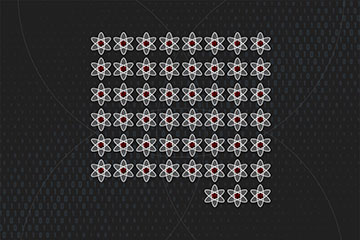
Researchers at Harvard and MIT reported using finely tuned lasers to trap and tweak the interactions of 51 individual atoms, or quantum bits. [Image: Christine Daniloff/MIT]
In a separate set of experiments, researchers at Harvard University and the Massachusetts Institute of Technology (MIT), USA, led by OSA Fellow Mikhail Lukin and colleague Markus Greiner at Harvard and OSA member Vladan Vuletić at MIT, built a quantum simulator composed not of ions, but of neutral atoms.
The team used a linear array of 101 evenly spaced optical tweezers with a beam waist of approximately 0.9 microns to create traps for 51 separate laser-cooled neutral 87Rb atoms. Then—in contrast to the JQI’s ion-trap experiment, which relied on the intrinsic charge of the ions to create the dipole moment for the quantum interaction—the Harvard/MIT group used lasers to excite selected atoms in the array to a highly excited Rydberg state.
The experiment, Vuletić explains, begins with the atoms in the ground state. This forms the input of the simulator. At that point, the trap is turned off and the system is allowed to evolve, with lasers used to adiabatically excite specific atoms in the array, and “slowly turn on antiferromagnetic coupling”—that is, a new ground state in which the spin alignments of the individual atoms alternate rather than being pointed in the same direction. The trap is turned back on, and the final states of the atoms are captured by atomic fluorescence imaging. The system thus was able to simulate the intricate phase transition from one ground state to a second, nontrivial (antiferromagnetic) one, within a state space involving 251 possible configurations.
Strength in diversity
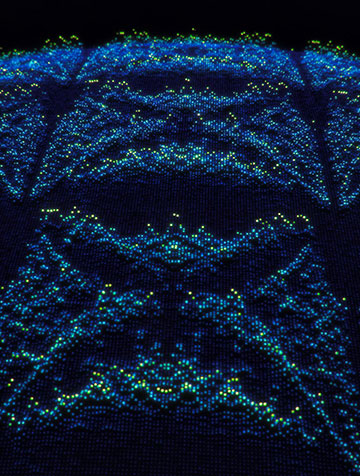
Using nine superconducting qubits, researchers at Google, UCSB, the National University of Singapore and Technical University of Crete simulated the intricate energy spectrum predicted for 2-D electrons in a magnetic field, the Hofstadter butterfly. [Image: Visual Science/Google]
The third experiment, from researchers at Google and the University of California, Santa Barbara (USA), the National University of Singapore, and the Technical University of Crete (Greece), used superconducting circuits on a chip previously designed by Google to simulate, with nine qubits, the “Hofstadter butterfly”—the predicted energy spectrum of two electrons in a magnetic field.
Monroe of JQI points out that the superconducting-circuit system has some advantages, notably that the interactions among qubits tend to be much faster than for the atomic systems and that the system in principle can take advantage of existing silicon-chip infrastructure. But the qubits in superconducting systems are artificial, and thus it’s much harder to make them identical with one another—a non-negotiable requirement of quantum-computing systems that’s ready out of the box with systems using collections of trapped atoms or ions. And, of course, the specific experiment involved a considerably smaller state space than the 50-qubit-plus JQI and Harvard/MIT experiments.
Still, in Monroe’s view, at this point in quantum computing’s development the diversity of approaches is a strength, not a weakness. “I think that having a community where people are looking at building their systems, but having bottlenecks in different areas—that’s important, actually,” he says. “Both hardwares will continue to develop as time goes on.”
Optimization problems
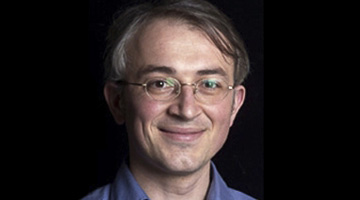
Vladan Vuletić. [Image: MIT]
In the short term, Vuletić stresses, quantum simulators such as the Harvard/MIT model are useful in themselves: Though not arbitrarily programmable, he explains, such a system can, by changing the end-state Hamiltonian to be simulated, potentially address a variety of hard problems of a specific class.
One target of the Harvard/MIT simulator, for example, might be various types of optimization problems, such as the so-called traveling-salesman problem, involving finding the shortest path to visit a list of cities. That’s a problem that becomes exponentially more difficult to solve as cities are added, and can quickly outstrip classical-computing capabilities. It’s also a type of problem that has many practical variations, in areas ranging from DNA sequencing to mapping to optimizing the efficiency of placing solder joints on a circuit board.
Toward universal quantum computing?
In a larger sense, though, the simulation results will inevitably prompt questions about how such systems might evolve into the universal quantum computers that have lately spurred increasing discussion, speculation and (perhaps) a bit of hype.
One next step will be finding ways to scale up the systems to several hundred qubits; another will be determining what sort of problems quantum computers are actually good at. The current situation with quantum computing, in Vuletić’s view, is “very much like when [conventional] computers first came about. People weren’t thinking about ‘a laptop in every household.’ They were thinking about, What problems can we use them to solve?”
For his part, Monroe of JQI sees great potential in scaling up his team’s trapped-ion simulator to a more powerful, programmable general-purpose machine. “To me, what makes this fun and interesting is that the physics that makes the interactions happen is exactly the same physics for quantum computing,” he says. Indeed, one of Monroe’s projects is a startup company that he cofounded, IonQ, that is working to solve the engineering, software and business-model problems involved in achieving a quantum computer that “can be used by real people.” “We have quite definite plans for scaling up, for sure,” he says.
However they come about, quantum computers, especially built on trapped-ion or trapped-atom techniques, are apt to look very different the classical version on your desk at work. The new machines will likely involve highly engineered arrays of lasers, lenses, mirrors and other optical components. “The principles of quantum computing differ radically from those of conventional computing,” Monroe noted in a press release accompanying his team’s paper. “There’s no reason to expect that these two technologies will look anything alike.”
